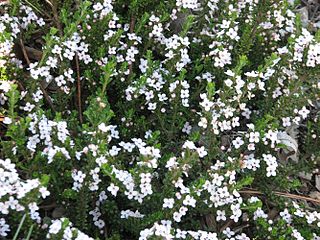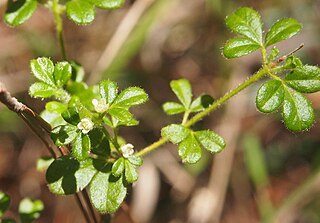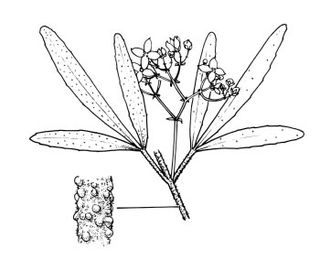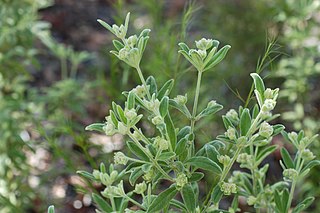Zieria lasiocaulis, commonly known as Willi Willi zieria, is a rare species of flowering plant in the citrus family Rutaceae and is endemic to New South Wales. It is a tall shrub or small tree with three-part leaves and inconspicuous white flowers, found only at high altitudes in areas with a high rainfall.

Zieria granulata, commonly known as the Illawarra zieria, hill zieria or hilly zieria, is a plant in the citrus family Rutaceae and is endemic to the Illawarra region of New South Wales. It is a tall, bushy shrub distinguished by the wart-like tubercles that cover the entire plant, its linear leaflets and small white, four-petalled flowers.

Zieria citriodora, commonly known as lemon-scented zieria, is a species of flowering plant in the citrus family Rutaceae and is endemic to a small area near the border between New South Wales and Victoria. It is a small shrub with lemon-scented leaves and small, pale pink or white flowers which appear from late winter to summer.

Zieria aspalathoides, commonly known as the whorled zieria, heath zieria, hairy zieria or heathy zieria, is a plant in the citrus family Rutaceae and is endemic to eastern Australia. It is a heath-like shrub with leaves that appear to be whorled and with pink flowers in groups of three, each with four petals and four stamens.

Zieria laevigata commonly known as smooth zieria, smooth-leaved zieria or twiggy midge bush is a species of flowering plant in the citrus family Rutaceae and is endemic to eastern Australia. It is an erect shrub with smooth, three-part leaves and pale pink or white flowers with four petals and four stamens. It grows in poor soil on rocky outcrops and flowers from late winter to spring.

Zieria arborescens, commonly known as the tree zieria or stinkwood, is a plant in the citrus family Rutaceae and is endemic to eastern Australia. It is a bushy shrub or small tree with branches that are ridged and scaly or hairy, at least when young. It has leaves composed of three leaflets and groups of flowers with four white petals, the groups usually shorter than the leaves.

Zieria minutiflora, commonly known as twiggy zieria, is a plant in the citrus family Rutaceae and is endemic to eastern Australia. It is a small, erect, twiggy shrub with leaves composed of three leaflets, and clusters of small white flowers with four petals and four stamens. It usually grows as an understorey shrub in eucalypt woodland.

Zieria caducibracteata is a plant in the citrus family Rutaceae and is endemic to New South Wales. It is a tall shrub or small tree with leaves composed of three lance-shaped leaflets. In early spring there are clusters of small white flowers with four petals near the ends of the branches.

Zieria covenyi, commonly known as the Coveny's zieria, is a plant in the citrus family Rutaceae and is endemic to a small area in the Blue Mountains of New South Wales. It is an erect shrub which multiples asexually from root suckers and has three-part, clover-like leaves and clusters of white to pink flowers with four petals and four stamens.

Zieria cytisoides, commonly known as the downy zieria, is a plant in the citrus family Rutaceae and is endemic to eastern Australia. It is a bushy shrub with three-part, clover-like leaves and small clusters of pale to deep pink flowers with four petals and four stamens.

Zieria floydii, commonly known as the Floyd's zieria, is a plant in the citrus family Rutaceae and is endemic to the New England Tableland in New South Wales. It is an erect shrub with warty, hairy branches, three-part, clover-like leaves and clusters of creamy-white flowers with four petals and four stamens.
Zieria hindii, commonly known as the Hind's zieria, is a plant in the citrus family Rutaceae and is endemic to a small area in north-eastern New South Wales. It is an erect, slender shrub with warty branches, three-part, clover-like leaves, and clusters of small white flowers with four petals and four stamens. It is only known from the Nightcap Range.

Zieria ingramii, commonly known as Keith's zieria, is a plant in the citrus family Rutaceae and is endemic to a small area in central New South Wales. It is a slender, spindly, aromatic shrub with three-part, clover-like leaves and clusters of about seven white to pale pink flowers with four petals and four stamens. The species is only known from two state forests near Dubbo.

Zieria involucrata is a plant in the citrus family Rutaceae and is endemic to New South Wales. It is a sparse, erect shrub with mostly three-part leaves and groups of up to 21 small white flowers, the groups shorter than the leaves. It mostly occurs in the lower Blue Mountains, but is also known from other areas around Sydney.
Zieria laxiflora, commonly known as wallum zieria, is a plant in the citrus family Rutaceae and is endemic to eastern Australia. It is an erect shrub with leaves composed of three leaflets, and clusters of about nine white or pale pink flowers with four petals and four stamens. It usually grows is coastal heathland.

Zieria littoralis, commonly known as dwarf zieria is a plant in the citrus family Rutaceae and is endemic to south-eastern Australia. It is an erect or spreading shrub with velvety, three-part, clover-like leaves and clusters of up to thirty white or pale pink flowers with four petals and four stamens. It grows on exposed, rocky coastal headlands.

Zieria murphyi, commonly known as Murphy's zieria, is a plant in the citrus family Rutaceae and endemic to New South Wales. It is a slender shrub with simple, or three-part leaves and between three and nine white to pale pink flowers with four petals and four stamens arranged in the leaf axils. It usually grows in sheltered places in open forest, often at the base of cliffs.

Zieria odorifera, commonly known as the fragrant zieria, is a plant in the citrus family Rutaceae and is endemic to inland New South Wales. It is an aromatic shrub with ridged branches, leaves composed of three leaflets and groups of mostly three pale to deep pink, four-petalled flowers in spring.

Zieria parrisiae, commonly known as Parris' zieria, is a plant in the citrus family Rutaceae and is endemic to a small area near Pambula on the south coast of New South Wales. It is a bushy shrub with warty, clover-like leaves composed of three leaflets and in spring there are clusters of up to 24 white to pale yellow flowers with four petals, near the ends of the branches.

Zieria pilosa, commonly known as hairy zieria, is a plant in the citrus family Rutaceae and is endemic to coastal New South Wales. It is a shrub with hairy branches, leaves composed of three leaflets and usually only single white to pale pink flowers in the leaf axils.
















